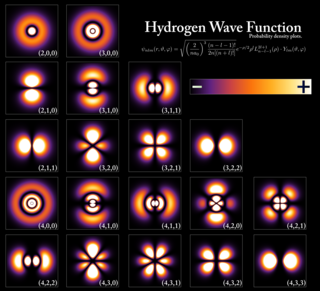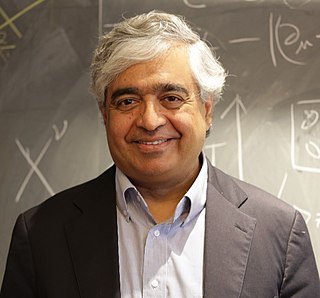Related Research Articles

Particle physics or high-energy physics is the study of fundamental particles and forces that constitute matter and radiation. The field also studies combinations of elementary particles up to the scale of protons and neutrons, while the study of combination of protons and neutrons is called nuclear physics.
A photon is an elementary particle that is a quantum of the electromagnetic field, including electromagnetic radiation such as light and radio waves, and the force carrier for the electromagnetic force. Photons are massless particles that always move at the speed of light measured in vacuum. The photon belongs to the class of boson particles.

Quantum mechanics is a fundamental theory that describes the behavior of nature at and below the scale of atoms. It is the foundation of all quantum physics, which includes quantum chemistry, quantum field theory, quantum technology, and quantum information science.

In theoretical physics, quantum field theory (QFT) is a theoretical framework that combines classical field theory, special relativity, and quantum mechanics. QFT is used in particle physics to construct physical models of subatomic particles and in condensed matter physics to construct models of quasiparticles. The current standard model of particle physics is based on quantum field theory.

Quantum entanglement is the phenomenon of a group of particles being generated, interacting, or sharing spatial proximity in such a way that the quantum state of each particle of the group cannot be described independently of the state of the others, including when the particles are separated by a large distance. The topic of quantum entanglement is at the heart of the disparity between classical and quantum physics: entanglement is a primary feature of quantum mechanics not present in classical mechanics.
The elementary charge, usually denoted by e, is a fundamental physical constant, defined as the electric charge carried by a single proton or, equivalently, the magnitude of the negative electric charge carried by a single electron, which has charge −1 e.
Supersymmetry is a theoretical framework in physics that suggests the existence of a symmetry between particles with integer spin (bosons) and particles with half-integer spin (fermions). It proposes that for every known particle, there exists a partner particle with different spin properties. There have been multiple experiments on supersymmetry that have failed to provide evidence that it exists in nature. If evidence is found, supersymmetry could help explain certain phenomena, such as the nature of dark matter and the hierarchy problem in particle physics.

Frank Anthony Wilczek is an American theoretical physicist, mathematician and Nobel laureate. He is the Herman Feshbach Professor of Physics at the Massachusetts Institute of Technology (MIT), Founding Director of T. D. Lee Institute and Chief Scientist at the Wilczek Quantum Center, Shanghai Jiao Tong University (SJTU), distinguished professor at Arizona State University (ASU) and full professor at Stockholm University.
The spin–statistics theorem proves that the observed relationship between the intrinsic spin of a particle and the quantum particle statistics of collections of such particles is a consequence of the mathematics of quantum mechanics. In units of the reduced Planck constant ħ, all particles that move in 3 dimensions have either integer spin and obey Bose–Einstein statistics or half-integer spin and obey Fermi–Dirac statistics.
In physics, an anyon is a type of quasiparticle so far observed only in two-dimensional systems. In three-dimensional systems, only two kinds of elementary particles are seen: fermions and bosons. Anyons have statistical properties intermediate between fermions and bosons. In general, the operation of exchanging two identical particles, although it may cause a global phase shift, cannot affect observables. Anyons are generally classified as abelian or non-abelian. Abelian anyons, detected by two experiments in 2020, play a major role in the fractional quantum Hall effect.
In mathematics and theoretical physics, braid statistics is a generalization of the spin statistics of bosons and fermions based on the concept of braid group. While for fermions (Bosons) the corresponding statistics is associated to a phase gain of under the exchange of identical particles, a particle with braid statistics leads to a rational fraction of under such exchange or even a non-trivial unitary transformation in the Hilbert space. A similar notion exists using a loop braid group.
The fractional quantum Hall effect (FQHE) is a physical phenomenon in which the Hall conductance of 2-dimensional (2D) electrons shows precisely quantized plateaus at fractional values of , where e is the electron charge and h is the Planck constant. It is a property of a collective state in which electrons bind magnetic flux lines to make new quasiparticles, and excitations have a fractional elementary charge and possibly also fractional statistics. The 1998 Nobel Prize in Physics was awarded to Robert Laughlin, Horst Störmer, and Daniel Tsui "for their discovery of a new form of quantum fluid with fractionally charged excitations". The microscopic origin of the FQHE is a major research topic in condensed matter physics.

In physics, topological order is a kind of order in the zero-temperature phase of matter. Macroscopically, topological order is defined and described by robust ground state degeneracy and quantized non-abelian geometric phases of degenerate ground states. Microscopically, topological orders correspond to patterns of long-range quantum entanglement. States with different topological orders cannot change into each other without a phase transition.

A topological quantum computer is a theoretical type of quantum computer proposed by Russian-American physicist Alexei Kitaev in 1997. It utilizes quasiparticles, known as anyons, in two-dimensional systems. These anyons' world lines intertwine to form braids in a three-dimensional spacetime. These braids act as the logic gates of the computer. The primary advantage of using quantum braids over trapped quantum particles is enhanced stability. While small, cumulative perturbations can cause quantum states to decohere and introduce errors in traditional quantum computations, such perturbations do not alter the topological properties of the braids. This stability is akin to the difference between cutting and reattaching a string to form a different braid versus a ball colliding with a wall.

A Majorana fermion, also referred to as a Majorana particle, is a fermion that is its own antiparticle. They were hypothesised by Ettore Majorana in 1937. The term is sometimes used in opposition to a Dirac fermion, which describes fermions that are not their own antiparticles.

Subir Sachdev is Herchel Smith Professor of Physics at Harvard University specializing in condensed matter. He was elected to the U.S. National Academy of Sciences in 2014, received the Lars Onsager Prize from the American Physical Society and the Dirac Medal from the ICTP in 2018, and was elected Foreign Member of the Royal Society ForMemRS in 2023. He was a co-editor of the Annual Review of Condensed Matter Physics 2017–2019, and is Editor-in-Chief of Reports on Progress in Physics 2022-.
Jainendra K. Jain is an Indian-American physicist and the Evan Pugh University Professor and Erwin W. Mueller Professor of Physics at Pennsylvania State University. He is also Infosys Chair Visiting Professor at IISc, Bangalore. Jain is known for his theoretical work on quantum many body systems, most notably for postulating particles known as Composite Fermions.
In quantum mechanics, fractionalization is the phenomenon whereby the quasiparticles of a system cannot be constructed as combinations of its elementary constituents. One of the earliest and most prominent examples is the fractional quantum Hall effect, where the constituent particles are electrons but the quasiparticles carry fractions of the electron charge. Fractionalization can be understood as deconfinement of quasiparticles that together are viewed as comprising the elementary constituents. In the case of spin–charge separation, for example, the electron can be viewed as a bound state of a 'spinon' and a 'holon ', which under certain conditions can become free to move separately.
Jon Magne Leinaas is a Norwegian theoretical physicist.
Jean Zinn-Justin is a French theoretical physicist.
References
- 1 2 "Jan Myrheim 50 år 14. februar" (in Norwegian). Norwegian News Agency. 28 January 1998.
- ↑ "Jan Myrheim". Store norske leksikon (in Norwegian). Retrieved 4 May 2014.
- ↑ Leinaas, J. M.; Myrheim, J. (January 1977). "On the theory of identical particles". Il Nuovo Cimento B. 37 (1): 1–23. Bibcode:1977NCimB..37....1L. doi:10.1007/BF02727953. ISSN 1826-9877. S2CID 117277704.